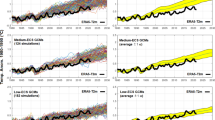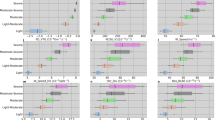Abstract
The paper presents a new version of the global three-dimensional general circulation model of the Earth’s thermosphere (90-500 km) with high spatial resolution (2 × 2.5 × 80), including consistent calculation of radiative processes. Based on a detailed analysis of the reproduction of the various components of radiation transfer a good agreement of radiation balance with empirical data is shown in the new model. Analytical estimations and model results proved that the thermosphere global state formation is essentially determined by the ratio between the radiation heating and heat sink due to molecular parameters, as well as by the lower boundary conditions. On the base of the preliminary model identification with empirical data a satisfactory reproduction of the thermal balance and the thermospheric general circulation features is shown.
Similar content being viewed by others
References
G. I. Marchuk, V. P. Dymnikov, and V. B. Zalesny, Mathematical Modeling of the General Circulation of the Atmosphere and Ocean (Gidrometeoizdat, Leningrad, 1984) [in Russian].
S. Chandra and A. K. Sinha, "The Role of Eddy Turbulence in the Development of Self-consistent Models of the Lower and Upper Thermospheres," J. Geophys. Res., No. 3, 79 (1973).
M. V. Codrescu, T. J. Fuller-Rowell, et al., "Validation of the Coupled Thermosphere Ionosphere Plasmasphere Electrodynamics Model: CTIPE-Mass Spectrometer Incoherent Scatter Temperature Comparison," Space Weather, No. 9, 6 (2008).
R. E. Dickinson, E. C. Ridley, and R. G. Roble, "A Three-dimensional General Circulation Model of the Thermosphere," J. Geophys. Res., 86 (1981).
V. I. Fomichev, A. A. Kutepov, R. A. Akmaev, and G. M. Shved, "Parameterization of the 15 im CO2 Band Cooling in the Middle Atmosphere," J. Atmos. and Solar-Terr. Phys., 55 (1993).
A. E. Hedin, "Extension of the MSIS Thermosphere Model into the Middle and Lower Atmosphere," J. Geophys. Res., No. A2, 96 (1991).
C. O. Hines, "Doppl er Spread Parameterization of Gravity Wave Momentum Deposition in the Middle Atmosphere. Part 1, Basic Formulation," J. Atmos. Terr. Phys., No. 4, 59 (1997).
T. L. Killeen, "Energetics and Dynamics of the Earth’s Thermosphere," Rev. Geophys., No. 3, 25 (1987).
D. V. Kulyamin and V. P. Dymnikov, "A Three-dimensional Model of General Thermospheric Circulation," Russ. J. Numer. Anal. and Math. Modelling, No. 4, 28 (2013).
D. V. Kulyamin and V. P. Dymnikov, "The Atmospheric General Circulation Model with a Hybrid Vertical Coordinate," Russ. J. Numer. Anal. and Math. Modelling, No. 6, 29 (2014).
M. G. Mlynczak and S. Solomon, "A Detailed Evaluation of the Heating Efficiency in the Middle Atmosphere," J. Geophys. Res., No. D6, 98 (1993).
A. I. Pogoreltsev, A. A. Vlasov, K. FrohlichK., and Ch. Jacobi, "Planetary Waves in Coupling the Lower and Upper Atmosphere," J. Atmos. Solar-Terr. Phys., 69 (2007).
M. Reise, D. Offermann, and G. Brasseur, "Energy Released by Recombination of Atomic Oxygen and Related Species at Mesopause Heights," J. Geophys. Res., No. D7, 99 (1994).
P. G. Richards, J. A. Fennelly, and D. G. Torr, "EUVAC: A Solar EUV Flux Model for Aeronomic Calculations," J. Geophys. Res., No. A5, 99 (1994).
P. G. Richards, M. R. Torr, and D. G. Torr, "Solar EUV Energy Budget of the Thermosphere," Adv. Space Res., No. 12, 1 (1981).
R. G. Roble, "The Calculated and Observed Diurnal Variation of the Ionosphere over Millstone Hill on March 23-24, 1970," Planet Space Sci., No. 7, 23 (1975).
R. G. Roble, E. C. Ridley, and R. E. Dickinson, "On the Global Mean Structure of the Thermosphere," J. Geophys. Res., 92 (1987).
R. W. Schunk and A. Nagy, Ionospheres: Physics, Plasma Physics, and Chemistry (Cambridge University Press, 2009).
K. P. Shine, J. A. Ricaby, Solar Radiative Heating due to Absorption by Ozone (Department of Atmospheric, Oceanic and Planetary Physics, University of Oxford, Oxford, UK, 1989).
R. S. Stolarski, P. B. Hays, and R. G. Roble, "Atmospheric Heating by Solar EUV Radiation," J. Geophys. Res., No. 16, 80 (1975).
D. F. Strobel, "Parameterization of the Atmospheric Heating Rate from 15 to 120 km due to O2 and O3 Absorption of Solar Radiation," J. Geophys. Res., No. 12, 83 (1978).
Author information
Authors and Affiliations
Corresponding author
Additional information
Original Russian Text © D.V. Kulyamin, V.Ya. Galin, A.I. Pogoreltsev, 2015, published in Meteorologiya i Gidrologiya, 2015, No. 6, pp. 48-57.
About this article
Cite this article
Kulyamin, D.V., Galin, V.Y. & Pogoreltsev, A.I. The thermosphere general circulation modeling with the parametrization of radiative processes. Russ. Meteorol. Hydrol. 40, 392–399 (2015). https://doi.org/10.3103/S1068373915060059
Received:
Published:
Issue Date:
DOI: https://doi.org/10.3103/S1068373915060059




